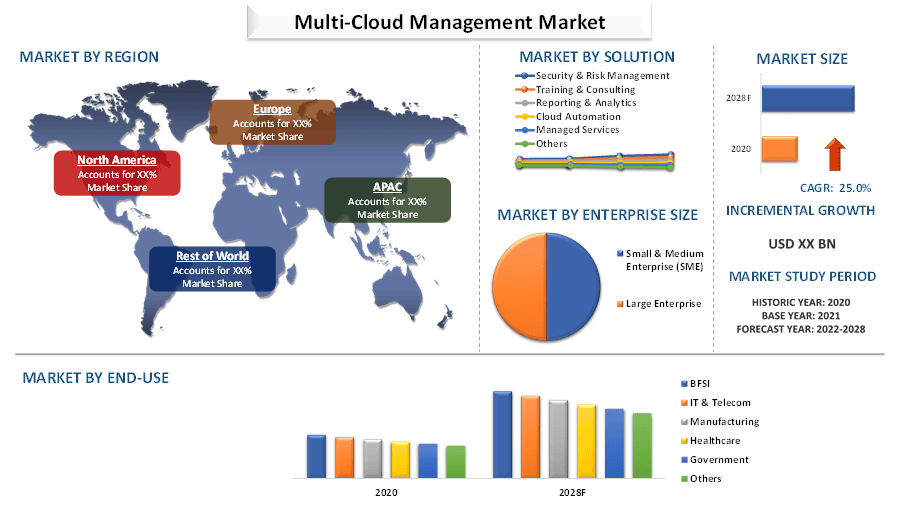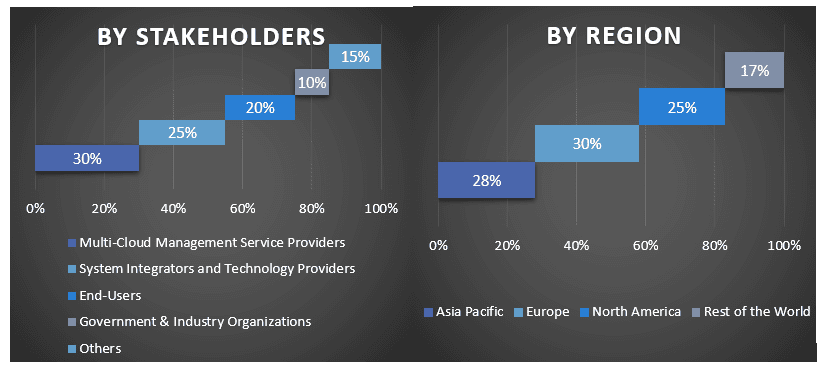- Home
- About Us
- Industry
- Services
- Reading
- Contact Us
Multi-Cloud Management Market: Current Analysis and Forecast (2022-2028)
Emphasis on Solution (Security & Risk Management, Training & Consulting, Reporting & Analytics, Cloud Automation, Managed Services, and Others); Enterprise Size (Small & Medium Enterprise (SME) and Large Enterprise); End-use (BFSI, IT & Telecom, Manufacturing, Healthcare, Government, and Others)); and Region/Country

The global Multi-Cloud Management Market is expected to grow at a significant rate of around 25% during the forecast period. Increasing concern over the reliability of a single cloud is anticipated to play a decisive role in driving the adoption rate of multi-cloud management solutions. However, rising concerns over data security and privacy protection coupled with the hardships that come across with redesigning the network for cloud-based infrastructure are restricting the growth of the market.
BMC Software, Inc., Citrix Systems Inc., CloudBolt Software, Inc., CoreStack, Dell Technologies Inc., Flexera, Jamcracker, Inc., Microsoft Corporation, UnityOneCloud, and VMware Inc. are some of the key players in the multi-cloud management market. Several mergers and acquisitions along with partnerships have been undertaken by the market players to facilitate customers with hi-tech and innovative products and technologies. For instance, in October 2020, UnityOneCloud launched a multi-cloud observability feature for detailed real-time observability through utilization charts, interactive widgets, and live status in data centers and multi-cloud infrastructure. This authorized end-users to allocate multi-cloud resources with the use of real-time monitoring insights on infrastructure devices’ usage, performance, and health.
Insights Presented in the Report
“Based on solution, cloud automation multi-cloud management segment category held significant market share in 2020”
Based on solution, the market is segmented into Security & Risk Management, Training & Consulting, Reporting & Analytics, Cloud Automation, Managed Services, and Others. The cloud automation segment led the market in 2021, with a market share of more than 25%. The market players are increasingly opting for automation for managing various public, private, and hybrid cloud environments with limited human resources. Machine learning (ML) and artificial intelligence (AI) are anticipated to play an important role in the decision-making of cloud automation (including extensive log analysis). Various systems and solutions based on ML and AI help in analyzing large volumes of logging data and searching for patterns. The results obtained can be used to foresee the failure of server components or the breakdown of applications. In other words, cloud automation helps in capacity planning by aiding in forecasting infrastructure needs and requirements.
“Amongst enterprise size, the large enterprise segment held a significant share in the market in 2020”
Based on enterprise size, the market is divided into Small & Medium Enterprise (SME) and Large Enterprise. The rising inclination of small and medium enterprises for adopting multi-cloud services is propelling the growth of the multi-cloud management market. Small and medium-sized enterprises are moving their applications to cloud-based platforms for reducing their dependency on a single factor. Further, with a multi-cloud approach, large organizations can selectively distribute their heavy workloads across several computing infrastructures. Such an approach can help save costs, encourage innovation, strengthen disaster management, ensure business continuity, and increase efficiency.
“Amongst end-use, the BFSI segment held a significant share in the market in 2020”
Based on end-use, the multi-cloud management market is segmented into BFSI, IT & Telecom, Manufacturing, Healthcare, Government, and Others. The BFSI segment led the multi-cloud management market in 2020, with a market share of more than 20%. In the BFSI industry, multi-cloud management helps in enhancing operational efficiency and ensuring prompt customer service. Also, the companies operating in the BFSI industry prefer multi-cloud environments to have a backup in the case of the failure of one cloud, as, another cloud could take over it. Adding to this, multi-cloud management also secures the workload settings and ensures that regulatory compliance is high. Further, the market players in the BFSI industry are majorly following inorganic growth strategies, such as mergers, acquisitions, partnerships, and collaborations, to sustain the competitive environment. For instance, in September 2021, Temenos collaborated with IBM Corporation for increasing the adoption of hybrid cloud in the BFSI industry vertical. Temenos announced the ease of access of ‘Temenos Transact next-generation core banking’ with Red Hat OpenShift on IBM Cloud. The main aim of the collaboration was to expand the multi-cloud market for the BFSI industry.
“North America to held a significant share in the multi-cloud management market”
North America led the multi-cloud management market in 2020 with a market share of more than 35%. Cloud services are transitioning in the region at a rapid pace, i.e., from isolated cloud solutions to platforms combining private IaaS, public, and onsite. The rising adoption of connected and IoT-enabled devices and the continued rollout of wireless connectivity have increased the demand for technologically advanced products and solutions. Thus, leading the market players to invest aggressively in the latest technologies for surviving in the competitive environment. Further, the growing demand for efficient computing frameworks is also contributing to the growth of the North American multi-cloud management market. On the other hand, the Asia-Pacific region is expected to witness the fastest growth rate during the forecast period, owing to the high internet penetration, increasing number of IT companies, and rising number of youth active on social media platforms.
Reasons to buy this report:
- The study includes market sizing and forecasting analysis validated by authenticated key industry experts.
- The report presents a quick review of overall industry performance at one glance.
- The report covers an in-depth analysis of prominent industry peers with a primary focus on key business financials, product portfolio, expansion strategies, and recent developments.
- Detailed examination of drivers, restraints, key trends, and opportunities prevailing in the industry.
- The study comprehensively covers the market across different segments.
- Deep dive regional and country-level analysis of the industry.
Customization Options:
The global multi-cloud management market can further be customized as per the requirement or any other market segment. Besides this, UMI understands that you may have your own business needs, hence feel free to connect with us to get a report that completely suits your requirements.
Table of Content
Research Methodology for the Multi-Cloud Management Market Analysis (2022-2028)
Analyzing the historical market, estimating the current market, and forecasting the future market of the global multi-cloud management market were the three major steps undertaken to create and analyze the adoption of multi-cloud management in major regions globally. Exhaustive secondary research was conducted to collect the historical market numbers and estimate the current market size. Secondly, to validate these insights, numerous findings and assumptions were taken into consideration. Moreover, exhaustive primary interviews were also conducted, with industry experts across the value chain of the global multi-cloud management market. Post assumption and validation of market numbers through primary interviews, we employed a top-down/bottom-up approach to forecasting the complete market size. Thereafter, market breakdown and data triangulation methods were adopted to estimate and analyze the market size of segments and sub-segments of the industry pertains to. Detailed methodology is explained below:
Analysis of Historical Market Size
Step 1: In-Depth Study of Secondary Sources:
Detail secondary study was conducted to obtain the historical market size of the multi-cloud management market through company internal sources such as annual reports & financial statements, performance presentations, press releases, etc., and external sources including journals, news & articles, government publications, competitor publications, sector reports, third-party database, and other credible publications.
Step 2: Market Segmentation:
After obtaining the historical market size of the multi-cloud management market, we conducted a detailed secondary analysis to gather historical market insights and share for different segments & sub-segments for major regions. Major segments are included in the report as a solution, enterprise size, and end-use. Further country-level analyses were conducted to evaluate the overall adoption of testing models in that region.
Step 3: Factor Analysis:
After acquiring the historical market size of different segments and sub-segments, we conducted a detailed factor analysis to estimate the current market size of the multi-cloud management market. Further, we conducted factor analysis using dependent and independent variables such as solution, enterprise size, and end-use of multi-cloud management. A thorough analysis was conducted for demand and supply-side scenarios considering top partnerships, mergers and acquisitions, business expansion, and product launches in the multi-cloud management market across the globe.
Current Market Size Estimate & Forecast
Current Market Sizing: Based on actionable insights from the above 3 steps, we arrived at the current market size, key players in the global multi-cloud management market, and market shares of the segments. All the required percentage shares split, and market breakdowns were determined using the above-mentioned secondary approach and were verified through primary interviews.
Estimation & Forecasting: For market estimation and forecast, weights were assigned to different factors including drivers & trends, restraints, and opportunities available for the stakeholders. After analyzing these factors, relevant forecasting techniques i.e., the top-down/bottom-up approach were applied to arrive at the market forecast for 2028 for different segments and sub-segments across the major markets globally. The research methodology adopted to estimate the market size encompasses:
- The industry’s market size, in terms of revenue (USD) and the adoption rate of the multi-cloud management across the major markets domestically
- All percentage shares, splits, and breakdowns of market segments and sub-segments
- Key players in the global multi-cloud management market in terms of products offered. Also, the growth strategies adopted by these players to compete in the fast-growing market
Market Size and Share Validation
Primary Research: In-depth interviews were conducted with the Key Opinion Leaders (KOLs) including Top Level Executives (CXO/VPs, Sales Head, Marketing Head, Operational Head, Regional Head, Country Head, etc.) across major regions. Primary research findings were then summarized, and statistical analysis was performed to prove the stated hypothesis. Inputs from primary research were consolidated with secondary findings, hence turning information into actionable insights.
Split of Primary Participants in Different Regions

Market Engineering
The data triangulation technique was employed to complete the overall market estimation and to arrive at precise statistical numbers for each segment and sub-segment of the global multi-cloud management market. Data was split into several segments & sub-segments post studying various parameters and trends in the areas of the solution, enterprise size, and end-use in the global multi-cloud management market.
The main objective of the Global Multi-Cloud Management Market Study
The current & future market trends of the global multi-cloud management market were pinpointed in the study. Investors can gain strategic insights to base their discretion for investments on the qualitative and quantitative analysis performed in the study. Current and future market trends determined the overall attractiveness of the market at a regional level, providing a platform for the industrial participant to exploit the untapped market to benefit from a first-mover advantage. Other quantitative goals of the studies include:
- Analyze the current and forecast market size of the multi-cloud management market in terms of value (USD). Also, analyze the current and forecast market size of different segments and sub-segments
- Segments in the study include areas of the solution, enterprise size, and end-use.
- Define and analysis of the regulatory framework for the multi-cloud management
- Analyze the value chain involved with the presence of various intermediaries, along with analyzing customer and competitor behaviors of the industry.
- Analyze the current and forecast market size of the multi-cloud management market for the major region.
- Major countries of regions studied in the report include Asia Pacific, Europe, North America, and the Rest of the World.
- Company profiles of the multi-cloud management market and the growth strategies adopted by the market players to sustain in the fast-growing market
- Deep dive regional level analysis of the industry
Related Reports
Customers who bought this item also bought










